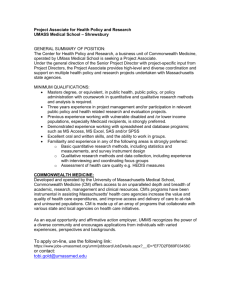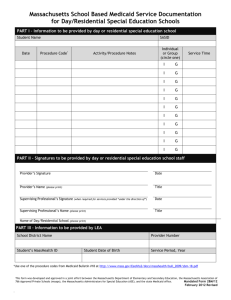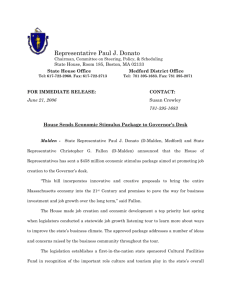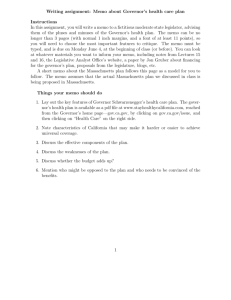Massachusetts’ Health Reform: Where Does It Stand?
advertisement
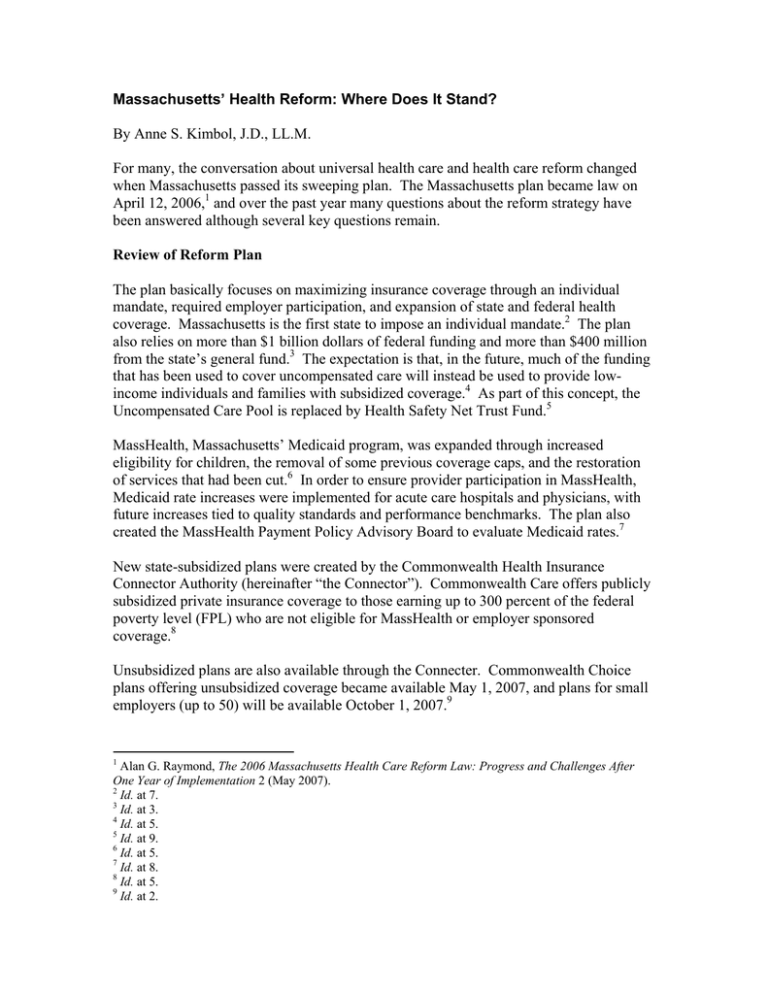
Massachusetts’ Health Reform: Where Does It Stand? By Anne S. Kimbol, J.D., LL.M. For many, the conversation about universal health care and health care reform changed when Massachusetts passed its sweeping plan. The Massachusetts plan became law on April 12, 2006,1 and over the past year many questions about the reform strategy have been answered although several key questions remain. Review of Reform Plan The plan basically focuses on maximizing insurance coverage through an individual mandate, required employer participation, and expansion of state and federal health coverage. Massachusetts is the first state to impose an individual mandate.2 The plan also relies on more than $1 billion dollars of federal funding and more than $400 million from the state’s general fund.3 The expectation is that, in the future, much of the funding that has been used to cover uncompensated care will instead be used to provide lowincome individuals and families with subsidized coverage.4 As part of this concept, the Uncompensated Care Pool is replaced by Health Safety Net Trust Fund.5 MassHealth, Massachusetts’ Medicaid program, was expanded through increased eligibility for children, the removal of some previous coverage caps, and the restoration of services that had been cut.6 In order to ensure provider participation in MassHealth, Medicaid rate increases were implemented for acute care hospitals and physicians, with future increases tied to quality standards and performance benchmarks. The plan also created the MassHealth Payment Policy Advisory Board to evaluate Medicaid rates.7 New state-subsidized plans were created by the Commonwealth Health Insurance Connector Authority (hereinafter “the Connector”). Commonwealth Care offers publicly subsidized private insurance coverage to those earning up to 300 percent of the federal poverty level (FPL) who are not eligible for MassHealth or employer sponsored coverage.8 Unsubsidized plans are also available through the Connecter. Commonwealth Choice plans offering unsubsidized coverage became available May 1, 2007, and plans for small employers (up to 50) will be available October 1, 2007.9 1 Alan G. Raymond, The 2006 Massachusetts Health Care Reform Law: Progress and Challenges After One Year of Implementation 2 (May 2007). 2 Id. at 7. 3 Id. at 3. 4 Id. at 5. 5 Id. at 9. 6 Id. at 5. 7 Id. at 8. 8 Id. at 5. 9 Id. at 2. Young Adult Plans are also available, which offer unsubsidized, low-cost products through the Connector to residents 19-26 years of age who do not have access to MassHealth, employer health coverage, or dependent health coverage.10 Failure by an individual to maintain creditable coverage if affordable coverage is available results in loss of personal income tax exemption for 2007 and monthly fines in 2008.11 Employers with 11 of more full-time equivalent employees also have requirements under the plan. They must set up a Section 125 cafeteria plan for employees by July 1, 2007 or potentially face a “free-rider” surcharge.12 Employers must all contribute their “fair share” to employee insurance coverage. This is defined as having 25 percent of all full time employees covered by the employer-sponsored insurance plan or covering 33 percent of the premium of an employer sponsored plan. Employers who do not meet these requirements must contribute $295 per uninsured employee per year into the Commonwealth Care Trust Fund.13 Employers must offer the same health benefits to all eligible employees living in Massachusetts and may not make higher premium contributions for higher-paid employees.14 To ensure compliance, employers must annually complete Employer Health Insurance Responsibility Disclosure (HIRD) forms.15 Other health reform measures include the merging of the state’s non-group and small group insurance rules and markets;16 the creation of the Health Disparities Council; the implementation of a study of the Community Health Outreach Worker Program;17 and cost and quality measures, such as the Health Care Quality and Cost Council, an infection prevention and control program, and a new wellness program for MassHealth enrollees.18 Current Status Within the last year, details of the plan have begun to take shape. Almost one-third of those believed to have been uninsured in June 2006 are now covered by MassHealth or Commonwealth Care plans,19 suggesting that the increased availability of subsidized plans is having a positive impact. 10 Id. at 6. Id. at 8. 12 Id. at 7. 13 Id. at 6. 14 Id. at 7. 15 Id. 16 Id. at 8. 17 Id. at 9. 18 Id. at 10. 19 Id. at 2. 11 The Connector has also been busy this year. While looking at affordability, the Connector decided to raise the threshold for fully subsidized plans from 100 percent FPL to 150 percent FPL.20 It also required insurance companies offering creditable coverage plans to provide four plan types with the same basic benefits but with different deductibles and levels of out-of-pocket costs.21 In the past year, the Connector established Commonwealth Care coverage and subsidy levels, decided which plans should receive its seal of approval, and defined minimum creditable coverage and affordable plans.22 Creditable coverage was defined as including: preventive and primary care services; emergency services; hospitalization benefits; ambulatory patient services; mental health services; and prescription drug coverage. The Connector prohibited insurance plans from establishing annual or per-sickness maximums or basing benefits on an indemnity fee schedule. It capped annual deductibles at $2,000 for an individual and $4,000 for families. Plans with upfront deductibles are required to cover a minimum number (3 for individuals, 6 for families) of preventive care visits prior to the deductible being enforced. Additionally, the Connector created out-of-pocket limits. Maximum out-ofpocket costs for in-network care are limited to $5,000 for individuals and $10,000 for families annually. This must include the upfront deductible, most co-insurance, and any service that requires a co-pay of $100 or more. Any separate deductible for drug coverage is limited to a maximum of $250 for an individual and $500 for a family.23 Affordability was also defined this year, as shown in Table 1. Coverage is seen as affordable if insurance can be purchased through an employer-sponsored plan, through the Connector, or directly from an insurer for an amount not exceeding the maximum monthly premium associated with the individual’s or families’ income bracket.24 Recognizing the different economic situations many individuals and families face, the Connecter created a waiver process. The Connector estimates that 1-2 percent of Massachusetts residents will be exempted from the individual mandate to purchase insurance due to the unavailability of affordable coverage.25 Table 1 – Definition of Affordability26 Single Couples Income Monthly Income Premium $0-15,315 $0 $0-20,535 $15,316-20,420 $35 $20,536-27,380 20 Id. at 16. Id. at 15. 22 Id. at 3. 23 Id. at 19-20. 24 Id. at 20-21. 25 Id. at 21. 26 Id. 21 Families with Children Monthly Income Monthly Premium Premium $0 $0-25,755 $0 $70 $25,756-34,340 $70 $20,421-25,525 $25,526-30,630 $30,631-35,000 $35,001-$40,000 $40,001-50,000 Above $50,000 $70 $105 $150 $200 $300 No limit $27,381-34,225 $34,225-41,070 $41,071-50,000 $50,001-60,000 $60,001-80,000 Above $80,000 $140 $210 $270 $360 $500 No limit $34,341-42,925 $42,926-51,510 $51,511-70,000 $70,001-90,000 $90,001-110,000 Above $110,000 $140 $210 $320 $500 $720 No limit Remaining Questions Several remaining issues exist that will determine the impact of the plan both in Massachusetts and nationwide. While employers have certain obligations under the Massachusetts plan, they are not required to offer policies that meet the minimum creditable coverage standard.27 The extent to which this information is publicized will determine whether employees with employer sponsored coverage truly understand the individual mandate and the differences between the employer’s responsibility and that of the employee. Additionally, it is unclear how this issue will play out. It is possible that employers will choose to offer plans that meet the creditable coverage definition, but it is equally possible, if not more likely, that due to premium costs employers will offer plans with lesser benefits. If that happens, Massachusetts may find itself with an entirely new insurance market – that for gap plans similar to those relating to Medicare that would fill in the gaps between employer sponsored plans and the requirements of the individual mandate. What impact such a market would have on affordability and whether this will undermine the employer health insurance market remains to be seen. Another looming question is whether affordable plans are really affordable. In a recent poll, approximately 60 percent of those asked said that the unsubsidized plans are not reasonably priced nor will they protect people from potentially high medical bills.28 Some of the affordability issues may be addressed by the waiver program, but it is not yet clear what standard the Connector will use to allow waivers. Also, if a significant number of waivers are granted, it will clearly reduce the effectiveness of the individual mandate and its presumed impact on lowering the need for safety net care. While the Connector will be reviewing its affordability definition annually, it does not take an economist to see that more than a few people are likely to find their idea of affordable on their budget vastly different from that of the Connector. Affordability for individuals is not the only money question. There are valid concerns about whether the plan will remain affordable for the state. Future budget forecasts include $125 million annually in general fund money to support the program, and that 27 Id. at 19. News Release, Kaiser Family Foundation, Harvard School of Public Health, and Blue Cross Blue Shield of Massachusetts Foundation, Poll Finds Most Mass. Residents Support New Health Reform Law, Including Individual Mandate, As Initial Deadline Nears (June 27, 2007), available at http://www.kff.org/kaiserpolls/kaiserpolls062707nr.cfm. 28 assumes that the current level of federal participation through Medicaid, Medicare, Upper Payment Limit, and Disproportionate Share Hospital payments continues. The program also may not address several of the key reasons that premiums are rising annually, including the costs of health care administration and the cost of prescription drugs,29 which could lead to higher budget requirements in out years. Furthermore, success for the plan means not only compliance with the new mandate but also use of new coverage for coordinated care management with resulting improvements in health.30 If people do not understand the mandate or the plans they have obtained, it is quite possible that no differences will be seen in emergency room use or health outcomes for Massachusetts residents. Also, even those who wish to comply and use their benefits may find doing so difficult. The Connector contracted with MassHealth to process applications for Commonwealth Care plans, but MassHealth has not increased staffing levels to accommodate these new applications,31 which could lead to long delays in obtaining coverage. Patients with coverage will also face delays due to significant increases in patient demand at community health centers32 and severe or critical shortages in a number of physician specialties. Provider shortages have lead to an increase in those waiting for primary care appointments; this year only 42 percent of patients were able to see a primary care doctor within a week of contacting the physician’s office, while 53 percent had gotten in within a week in 2006.33 If residents have coverage but can not see a healthcare provider, Massachusetts will find that insurance coverage is not the same as access to care and therefore may not improve health status. Another possibility is that those who comply with the minimum creditable coverage standard will find themselves underinsured. This is particularly true for those who have the Young Adult Plans that do not have to follow the Connector’s creditable coverage definition. Individuals who have health needs not covered by their insurance will either face high medical bills or will need to rely on whatever remains of the safety net. It is not clear whether or to what extent this issue has been considered by the Connector or others involved in the reform plan. It is unclear what impact the plan will have on safety net costs. Those not covered by the mandate due to affordability issues and undocumented workers will continue to need health care.34 A recent proposal to limit the Free Care Pool despite little evidence that limiting the safety net would improve participation in health insurance market35 29 Robert Steinbrook, Health Care Reform in Massachusetts – A Work in Progress, 354 NEW ENG. J. MED. 2095, 2095 (May 18, 2006). 30 Raymond 25. 31 Id. 32 Robert Preer, Booming business: Newly insured have phones ‘ringing off the hook’ at health centers, The Boston Globe, September 9, 2007, available at http://www.boston.com/news/local/articles/2007/09/09/booming_business?mode=PF 33 Michael McAuliffe, State shortage of doctors growing worse, MassLive, September 8, 2007, available at http://blog.masslive.com/breakingnews/2007/09/state_shortage_of_doctors_grow/print.html. 34 Id. at 26. 35 Benjamin Day, The dark side of healthcare reform, The Boston Globe, August 30, 2007, available at http://www.boston.com/news/globe/editorial_opinion/oped/articles/2007/08/30/the_dark_side_of_healthcar e_reform. demonstrates the possible negative outcomes for those seeking uncompensated care as implementation of the Massachusetts plan continues. Also at issue is whether the plan will remain in effect. There are potential ERISA preemption issues that could derail the plan. The fair share contribution requirement could be viewed as a requirement that directly regulates employers’ plans, thereby leading to ERISA preemption. Challenges to the law could also be made based on the Section 125 plan requirement, but that may not be viewed as impacting ERISA plans since it allows for premium only plans.36 However, until an ERISA challenge is made and the case is fully litigated, it remains possible that the reforms adopted will never get the chance to meet their full potential. Another overarching question is not focused on Massachusetts per se but on the ability to implement the Massachusetts plan in other states. As Massachusetts tends to have a high percentage of residents who have health insurance through employers and a low percentage of uninsured residents,37 the state was in a better fiscal position to attempt universal coverage mandates than many other states. Particularly when one considers the large general fund support required by a plan in a state with the demographics of Massachusetts, it is easy to see how other states would find implementation of such a program economically unfeasible. Conclusion Given the number of health reform proposals being made in this election cycle, it will be interesting to see if the Massachusetts plan, which currently seems a basis for many similar proposals, achieves its goals and, given the potential ERISA issue, remains in effect long enough to provide needed information on the effect of universal coverage on the cost of safety net care. Even if it does, questions about whether the plan is a good model for other states and whether reform should focus on coverage or direct access to care will continue to be hot topics for debate. 36 Katherine J. Utz, The Massachusetts Health Care Reform Act: What Must Employers Do?, Current Developments in Employment Law, American Law Institute-American Bar Association Continuing Legal Education 1885, 1891-1892 (July 26-28, 2007). 37 Steinbrook, supra note 29, at 2096.


